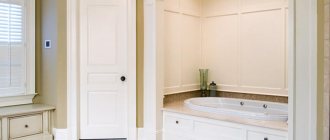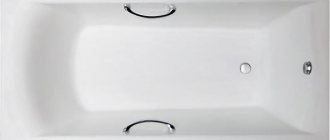Finishing a bathtub with natural stone is an ancient tradition in some European countries. In those days, such an interior was used during the construction of public baths and was considered irreplaceable due to its excellent performance indicators, the main one being resistance to high humidity and direct contact with water. Currently, the use of natural stone is very rare; for many users this material is too expensive. And artificial stone began to enjoy noticeable success.
Bathroom made of artificial stone
What are its advantages?
- Relatively low cost compared to natural stone. Of course, the price of artificial stone is many times higher than various budget options for finishing bathrooms, but this does not become a significant reason to refuse such a material.
- Excellent performance. In terms of strength, wear resistance, endurance to dynamic and static loads, artificial stone has no equal among all finishing materials.
- Decorative characteristics. Artificial stone has many more textures than natural stone, this is one of the advantages of the material. The choice of colors and sizes is huge.
- Manufacturability. Although finishing walls and floors with artificial stone has its own differences, the installation process consists of the same steps as for ordinary ceramic tiles. The same set of tools is required, except for the cutter.
- Durability. Due to its high physical strength, artificial stone can be used for decades. Unlike natural material, it has two very important properties: maintainability and plasticity. In case of mechanical damage, the surface of the artificial stone can be restored to its original appearance without dismantling or completely replacing the tiles. Due to its plasticity, the material can withstand impact loads and not crumble.
artificial stone for interior wall decoration
Decorating the bathroom with artificial stone
Spectacular interior of a spacious bathroom with stone walls
As an example, we will look at the process of lining the walls and floor of a bathroom with artificial stone.
Interior Design Styles for Stone Bathtubs
Stone in the interior is used to create designs in classical and neoclassical styles. Such styles are called pompous. And marble is an excellent way to create a luxurious interior. You can use the castle style - this is an interesting option for using stone in the interior. In techno and high-tech styles, stone is used to give the design angular and slightly rough shapes. In country style, in addition to wood, stone is also used. In the loft style, stone introduces elements of brutality into the premises. Art Nouveau and eco-style promote the use of natural materials, which means that stone will fit perfectly into such spaces.
Photo: svetlananikitenko.by
1/2
Photo: thefreepatriot.org
2/2
Material for making bathtubs
When making baths from natural stone, craftsmen choose granite, marble, onyx or sandstone. They do not contain any impurities, and specialists simply take a solid piece of stone and, using mechanical processing, give it the desired shape. The product is then polished and sometimes varnished.
The main materials in the composition of artificial stone are polymer concrete and stone chips from granite, malachite, marble, serpentine, onyx, and jasper. The composition contains synthetic binders: quartz sand, polyester resins of different colors, catalyst.
Externally, bathtubs made of natural and artificial stone are no different.
Photo: sheetfedmachines.com
1/2
Photo: cdn.shopify.com
2/2
How to make an illusion faux marble
If you want imitation stone to cover an elegant coffee table, you will have to abandon the previously described technology, since it is unlikely that thin wooden legs will withstand the load of a multi-kilogram slab. Instead, the easiest way is to use paints to partially turn the table itself into marble by painting the appropriate stains on it. To do this, you will need a jar of paint for the background, for example, white or green, as well as a small container of color for the pattern. It would be more correct to draw black or gray stripes on a white background, and white stripes on a green or black background.
Before making artificial marble, all cracks and chips on the surface, if any, are filled with a special water-based wood filler. Next, we moisten the tabletop with a spray bottle so that the swollen fibers reveal all the roughness, and, after the 30 minutes required for drying, we sand it as best as possible to a smooth state. Then, having cleaned the surface, we proceed to painting and apply two background layers with the interval necessary for the first of them to dry. To avoid streaks, it is better to use a brush or foam pad. After two hours, you can begin applying the texture pattern.
The pattern of marble is familiar to many; sometimes it resembles zigzags of lightning on a surface speckled with many grains, and sometimes it looks like randomly intersecting cracks. All this is not difficult to depict with a pen brush, with which you can change the thickness of the line. After waiting 5 minutes, mix a small amount of white paint with a transparent polyacrylic coating. Having dipped a wet sponge into the mixture (be sure to remove excess mixture from it), we follow the drawing without pressing hard and thus shade the lines, making them more blurry. After another 5 minutes of drying, wipe the surface with a clean cloth, mixing the colors with light touches. Another 30 minutes of drying and we take up the feather brush again, emphasizing the previously applied and already modified pattern.
After two hours, when the surface has already dried well, we take a thoroughly mixed polyacrylic coating and cover our “marble” with a thin transparent layer. It is advisable to leave the tabletop for a long time after this to allow the film to harden thoroughly. Next, you need to polish the surface with the finest sandpaper, clean it with a damp sponge or cloth and, after letting it dry, treat it again with polyacrylic. Again, we leave the almost formed imitation stone to dry for 2-3 hours, then polish and wipe again. We apply the last layer of transparent coating, wait for it to harden (2-3 hours), and finally polish it, after which we forget about our piece of furniture for about a week.
Benefits of stone baths
Due to the high cost, buyers often doubt whether to buy a stone bathtub. First of all, people pay attention to her external qualities. This bathtub is practical and multifunctional in use.
The main advantage of a bathtub made of natural stone is its high strength; it is considered eternal.
To obtain stone chips, which are part of artificial stone bathtubs, natural materials are used. Therefore, such a bath is environmentally friendly.
Both natural and artificial stone have low thermal conductivity, so the water in the bath remains warm for a long time.
Another advantage of these baths is that the surface does not absorb dirt; mold, bacteria and germs do not grow on it.
Externally, stone baths are attractive and look very stylish. Stone products absorb sound, so water flows silently through such a bathtub.
Roca bath
Bathtub Jacob Delafone
Photo: vivalusso.ru
1/2
Photo: i.pinimg.com
2/2
Bathroom with artificial stone
Polymer stone in the bathroom is used for decoration and furniture. Plumbing fixtures and furniture are made from it.
Floor
For laying on the bathroom floor:
- artificial marble;
- agglomerate;
- porcelain stoneware
Artificial marble is divided into two types:
- bulk;
- with concrete filler.
The poured stone is enhanced by adding ground granite chips to the resin base. Electric or water heated floors are not installed under artificial granite of the first group. This is due to the deformation of polymers when heated. The thermal conductivity of artificial granite is higher than that of wood and plastic, so you will need slippers or bathroom rugs.
Artificial granite is essential when creating a classic style in the bathroom. The surface retains its shine and does not allow water to pass through, so you don’t have to worry about drops falling onto the surface. When laying, attention is paid to the seams: the stone is placed end-to-end to create a feeling of solidity. Also, water will not leak into the seam.
Porcelain tiles are a step in the development of ceramic tiles. The appearance of the finish is similar to natural stone. It is made from purified clay. Pigments are added to it to give pattern and shade. Spar and quartz sand are used as fillers.
The components are crushed and pressed. The formed mass is baked under pressure and a temperature of 1300 degrees, turning into a monolithic tile. Like cast marble, there are no pores on the surface. When heated, the geometry of the stone does not change, so a heated floor is installed under it. With the latter, the bathroom becomes cozy and warm.
The pattern of porcelain tiles extends to the entire depth, so the surface does not wear down during constant use. The photo shows a wood imitation finish. The comfort of wood is combined with the practicality of stone. The installation sequence is the same as for tiles.
Porcelain stoneware is an environmentally friendly material, since no synthetic additives or resins are used in production. A stone with a rough surface would be practical for a bathroom. It doesn't glide as smoothly as a smooth one, but it is hygienic.
Agglomerate is practical for bathroom floors. According to the production method, the material is similar to artificial granite. Depending on the litter cat, it can be:
- quartz;
- marble;
- granite.
If you mix crushed mineral filler with pigment, the bathroom floor will turn from gray to yellow, red or turquoise. The shade does not fade in the sun and does not fade with use. The polymer resin coating is resistant to acids and alkalis, so you can use household chemicals to clean the surface.
The agglomerate expands under the influence of temperature, which violates the integrity of the coating. Therefore, no heating is used with it.
Walls
The walls in the bathroom are decorated with the same type of artificial stone that is used for the flooring. But this method requires significant costs. The solution is not suitable for small bathrooms, since the room is visually reduced. You can use it for walls:
- liquid marble;
- touchstone marble;
- gypsum stone.
Oselkovy marble is made from gypsum. The material is fragile, so before installation it is necessary to strengthen it and give it an attractive appearance. This is done during the production process. Glue diluted with water is applied to the canvas. Plaster is laid on top. When placed, the white color and powder with dye alternate, this creates veins similar to natural stone. An example is visible in the photo above.
The shades for the oskelet marble pigment are selected to match the interior. The adhesive water makes the material waterproof. The shine appears after polishing the base with fine-grained stones.
Touchstone material, laid in fragments, makes accents in the bathroom. Combines with light colors that visually expand the space in the room.
Touchstone is combined with natural or artificial marble. An example of alternation is shown in the photo above.
Liquid marble is a new material for wall decoration. It is made using a similar method as injection molding, but with acrylic resins. The filler is marble chips or a mineral that gives a pattern. The canvas is obtained with a thickness of 2 mm or more, cut with scissors, so it is adjusted to the curved shapes of the finish and glued to the walls, like wallpaper. Glues to arches and openings without kinks.
The light flux is not blocked due to the small thickness of the artificial material, so lighting is mounted behind it to create a pleasant atmosphere in the bathroom. After gluing, no seams are visible, so the surface is monolithic.
The dry area in the bathroom is finished with gypsum stone. It is cast in silicone molds. Their height, width and print are made according to the user's order. The disadvantage of the material is porosity, due to which moisture lingers on the walls. The problem is solved with a waterproof, non-toxic varnish that adds shine and closes pores. During production or after drying, the blocks are painted with water-based paint.
Ceiling
It is important to be careful when decorating the ceiling with artificial stone in the bathroom. A monolithic surface with a pattern visually reduces the height of the room. With a ceiling height of 2.5 meters, a fragmentary finish is suitable. The photo shows a version of stone finishing with a wood pattern. The natural array will be spoiled by the condensed steam that remains after taking a bath. The stone is wiped with a sponge and the problem is solved.
Liquid marble is suitable for gluing the ceiling, which will create a single contour with the walls. There will be no difficulties with installing lighting fixtures, since the soft stone does not crumble, and the holes are cut with a stationery knife.
Gypsum stone looks great on high ceilings. A gray or beige shade fills the room with coziness. Bright colors are used to place accents where the decoration requires it. The light weight of the stone makes it easier to stick to the surface. Environmentally friendly materials are used in production and fixation, so there are no harmful emissions when there is a change in humidity or temperature.
The photo shows a smooth transition in decoration from the walls to the ceiling. It is fragmentary, but is combined with the picture of the interior of the room.
Windows and doors
You can emphasize the shape of window and door openings with artificial stone. It is laid around the perimeter or on slopes. The material is selected with the same color, size and texture. A single-color stone can look rough, so an overflow of two tones is done. For good adhesion to the wall, the turn of the stone is made rough. The ends of the stone laid end to end must be smooth so that the seam emphasizes the integrity of the finish. Large inclusions in the stone affect the appearance, so when purchasing it is important to weed out defects.
One of the finishing options is to preserve the seam. When laying stone, plastic wedges are installed similar to tile wedges. They maintain the same distance between the stones. An example of the work is visible in the photo. To preserve the integrity of the interior, fragmentary sections are also made in the corners. Work on window slopes begins from the bottom corner in order to bring the planes level.
Laying the material on door or window slopes is done with jointing. In this case, the distance between the elements is closed with glue or acrylic mastic. The advantage is that the seam is sealed and the back of the material is protected from moisture. The space is filled with a syringe or narrow spatula. Excess fresh mastic is removed with a damp cloth so that no traces remain.
With monolithic masonry, the seams are leveled. To do this, the ends of the material must be smooth or processed with a float before gluing. When jointing, unevenness of the masonry is hidden. It is impossible to hide defects in a monolithic drawing, so the vertical and horizontal levels of the work are controlled. The solution is applied in quantity so that the material does not protrude into the joints.
Disadvantages of stone baths
Among the disadvantages, it can be noted that a bathtub made of natural stone is heavy and expensive.
Such baths are made from stones that may contain radioactive substances. An artificial stone product requires constant polishing.
Bathtubs made of artificial and natural stone are easy to paint, so you should not pour coloring liquid into them. Do not rub them with a metal brush, so as not to damage the surface. If a crack appears, restore the bathtub immediately, otherwise you will have to repair the whole thing later.
Photo: i.pinimg.com
1/2
Photo: richstone.by
2/2










